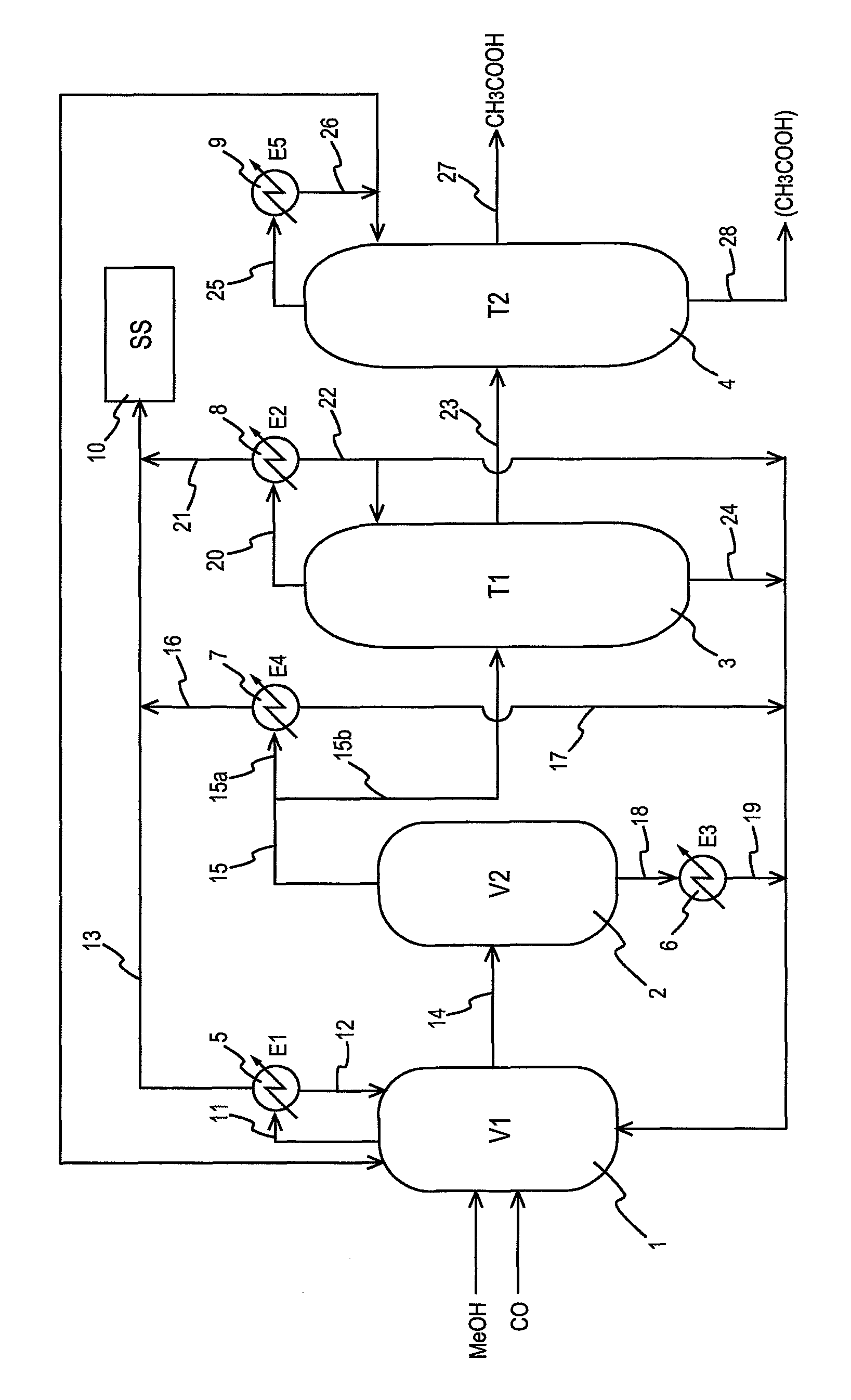Process for producing acetic acid
a technology of acetic acid and acetic acid, which is applied in the preparation of carboxylic compounds, carbon monoxide reaction carboxylic preparations, organic chemistry, etc., can solve the problems of insufficient heat removal method utilizing latent heat of evaporation to remove reaction heat, small amount of heat removed, and high cost of equipment. , to achieve the effect of high purity, high yield and high purity
- Summary
- Abstract
- Description
- Claims
- Application Information
AI Technical Summary
Benefits of technology
Problems solved by technology
Method used
Image
Examples
example 1
[0097]The plant shown in the diagram of FIG. 1 was continuously operated in the same manner as in Comparative Example 1. Specifically, the reaction heat was removed by using the condenser E1, the condenser E2, the heat exchanger E3, and the heat exchanger E4. The yield and purity of the resulting acetic acid in Example 1 ware almost the same as those in Comparative Example 1.
[0098]The balance of the heat quantity in the plant of Comparative Example 1 and that in the plant of Example 1 were compared. The results are shown in Table 1.
[0099]
TABLE 1Balance of Heat Quantity [unit: kcal / hour]TotalE1E2E3E4quantityCom. Ex. 11.9 × 1053.4 × 107——3.4 × 107Ex. 11.9 × 1052.0 × 1077.1 × 1066.3 × 1063.4 × 107
[0100]Moreover, assuming that the feed amount (t / hour) of the condenser E1 in Comparative Example 1 was 1, the feed amount of the first distillation column T1, that of the heat exchanger E3, and that of the heat exchanger E4 were expressed as relative values. The results are shown in Table 2.
[...
example 2
[0106]The plant shown in the diagram of FIG. 1 was continuously operated in the same manner as in Comparative Example 2. Specifically, the reaction heat was removed by using the condenser E1, the condenser E2, the heat exchanger E3, and the heat exchanger E4. Incidentally, as described later, Example 2 is different in feed amount from Example 1. The yield and purity of the resulting acetic acid in Example 2 ware almost the same as those in Comparative Example 2.
[0107]The balance of the heat quantity in the plant of Comparative Example 2 and that in the plant of Example 2 were compared. The results are shown in Table 4.
[0108]
TABLE 4Balance of Heat Quantity [unit: kcal / hour]TotalE1E2E3E4quantityCom. Ex. 21.9 × 1052.2 × 1071.2 × 107—3.4 × 107Ex. 21.9 × 1052.0 × 1071.2 × 1072.5 × 1063.4 × 107
[0109]Moreover, assuming that the feed amount (t / hour) of the condenser E1 in Comparative Example 1 was 1, the feed amount of the first distillation column T1, that of the heat exchanger E3, that of...
example 3
[0115]The plant shown in the diagram of FIG. 1 was continuously operated in the same manner as in Comparative Example 3. Specifically, the reaction heat was removed by using the condenser E1, the condenser E2, the heat exchanger E3, and the heat exchanger E4. The yield and purity of the resulting acetic acid in Example 3 ware almost the same as those in Comparative Example 3.
[0116]The balance of the heat quantity in the plant of Comparative Example 3 and that in the plant of Example 3 were compared. The results are shown in Table 7.
[0117]
TABLE 7Balance of Heat Quantity [unit: kcal / hour]TotalE1E2E3E4E6quantityCom. 6.2 × 1051.1 × 107 0.6 × 107 —1.6 ×3.4 × 107 Ex. 3107 Ex. 36.2 × 1051.1 × 1071.0 × 1071.2 × 107 —3.4 × 107
[0118]Moreover, assuming that the feed amount (t / hour) of the condenser E1 in Comparative Example 1 was 1, the feed amount of the first distillation column T1, that of the heat exchanger E3, that of the heat exchanger E4, that of the second distillation column T2, and t...
PUM
| Property | Measurement | Unit |
|---|---|---|
| partial pressure | aaaaa | aaaaa |
| partial pressure | aaaaa | aaaaa |
| partial pressure | aaaaa | aaaaa |
Abstract
Description
Claims
Application Information
 Login to View More
Login to View More - R&D
- Intellectual Property
- Life Sciences
- Materials
- Tech Scout
- Unparalleled Data Quality
- Higher Quality Content
- 60% Fewer Hallucinations
Browse by: Latest US Patents, China's latest patents, Technical Efficacy Thesaurus, Application Domain, Technology Topic, Popular Technical Reports.
© 2025 PatSnap. All rights reserved.Legal|Privacy policy|Modern Slavery Act Transparency Statement|Sitemap|About US| Contact US: help@patsnap.com

